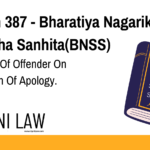Code
(1) When, upon an application made to it in this behalf or otherwise, any Court
is of opinion that it is expedient in the interests of justice that an inquiry should be made
into any offence referred to in clause (b) of sub-section (1) of section 215, which appears to
have been committed in or in relation to a proceeding in that Court or, as the case may be, in
respect of a document produced or given in evidence in a proceeding in that Court, such
Court may, after such preliminary inquiry, if any, as it thinks necessary,—
(a) record a finding to that effect;
(b) make a complaint thereof in writing;
(c) send it to a Magistrate of the first class having jurisdiction;
(d) take sufficient security for the appearance of the accused before such
Magistrate, or if the alleged offence is non-bailable and the Court thinks it necessary
so to do, send the accused in custody to such Magistrate; and
(e) bind over any person to appear and give evidence before such Magistrate.
(2) The power conferred on a Court by sub-section (1) in respect of an offence may,
in any case where that Court has neither made a complaint under sub-section (1) in respect
of that offence nor rejected an application for the making of such complaint, be exercised by
the Court to which such former Court is subordinate within the meaning of sub-section (4)
of section 215.
(3) A complaint made under this section shall be signed,—
(a) where the Court making the complaint is a High Court, by such officer of the
Court as the Court may appoint;
(b) in any other case, by the presiding officer of the Court or by such officer of
the Court as the Court may authorise in writing in this behalf.
(4) In this section, “Court” has the same meaning as in section 215.
Explanation of Section 379 BNSS
Section 379 of the Bharatiya Nagarik Suraksha Sanhita (BNSS) outlines the procedure that a Court must follow when dealing with offences mentioned in Section 215. Specifically, it provides the steps a Court must take when an offence is suspected to have been committed in relation to a proceeding within that Court or in relation to a document used in evidence during a proceeding.
Key Points of Section 379 BNSS:
-
Preliminary Inquiry:
The Court may conduct a preliminary inquiry if it deems necessary to determine whether an offence, as mentioned in Section 215, has been committed in relation to the case. -
Recording a Finding:
If the Court concludes that an offence may have occurred, it will record a finding to that effect. -
Making a Complaint:
The Court is required to make a written complaint and send it to a Magistrate of the first class having jurisdiction. -
Security for Appearance:
The Court may require sufficient security for the accused to appear before the Magistrate or, if the offence is non-bailable, may send the accused to custody. -
Binding Over Witnesses:
The Court can also bind over individuals to appear and provide evidence before the Magistrate. -
Power of Subordinate Court:
If the Court does not take action on the complaint, the power to proceed with the matter can be transferred to the Court subordinate to it. -
Complaint Signing:
The complaint must be signed by the appropriate officer, depending on whether the Court is a High Court or a lower Court.
Illustration
Example 1: Inquiry into a Document in Court
A Court is handling a case where a document has been presented as evidence. Upon suspicion, the Court believes that the document might have been tampered with. After conducting a preliminary inquiry, the Court decides to proceed under Section 379 BNSS. It records its findings, makes a formal complaint, and sends it to the Magistrate, along with taking necessary actions like securing the accused’s appearance.
Example 2: Non-Bailable Offence
In a case where a person is suspected of committing an offence under Section 215, the Court finds that the offence is non-bailable and orders that the accused be sent to the custody of the Magistrate. The Court also ensures that security is taken for the accused’s future appearance before the Magistrate.
Common Questions and Answers on Section 379 BNSS
1. What does the Court need to do if it suspects an offence in relation to a proceeding?
- Answer: The Court will conduct a preliminary inquiry, record a finding, make a written complaint, send the complaint to a Magistrate, and may require security for the accused’s appearance or send the accused to custody if necessary.
2. Can the power under Section 379 BNSS be exercised by a Court other than the one conducting the inquiry?
- Answer: Yes, if the Court making the inquiry does not take action, the power can be transferred to the subordinate Court within the meaning of Section 215(4).
3. Who signs the complaint under Section 379 BNSS?
- Answer: If the Court is a High Court, the complaint is signed by an officer appointed by the High Court. In any other case, it is signed by the presiding officer of the Court or another authorized officer.
4. What happens if the offence is non-bailable?
- Answer: If the offence is non-bailable, the Court may send the accused to custody and ensure that sufficient security is taken for the accused’s appearance before the Magistrate.
Conclusion
Section 379 BNSS provides a clear procedure for handling suspected offences that occur in relation to Court proceedings or documents. The section ensures that an inquiry can be conducted, appropriate complaints can be made, and that the rights of both the accused and witnesses are protected throughout the legal process.








